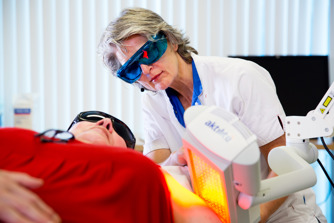Photodynamic therapy (PDT) for skin cancer
The Netherlands Cancer Center is the specialized center for Photodynamic therapy (PDT) for skin cancer in the Netherlands. Because this treatment option does not require incisions in the skin, the results are often cosmetically good. But even more important - most patients will have their entire tumor removed.
PDT can be used as a treatment for:
- Precursors for squamous cell carcinoma (actinic keratosis; UV lighting damage on the skin)
- Early stage squamous cell carcinoma (squamous cell carcinoma in situ, also known as Bowen’s disease)
- Superficial basal cell carcinoma
 nl
nl
 Nederlands (Nederland)
Nederlands (Nederland)
 English (United States)
English (United States)
